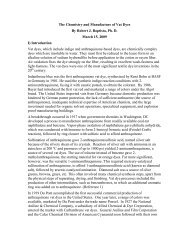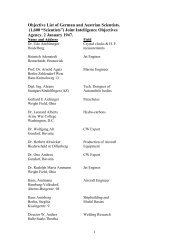International Dyestuff Industry - ColorantsHistory.Org
International Dyestuff Industry - ColorantsHistory.Org
International Dyestuff Industry - ColorantsHistory.Org
You also want an ePaper? Increase the reach of your titles
YUMPU automatically turns print PDFs into web optimized ePapers that Google loves.
*Dr. Peter J. T. Morris is Manager of Research and Residencies at the Science Museum,<br />
London SW7 2DD, London, Great Britain. This paper was written while he was the<br />
1991-1992 Edelstein <strong>International</strong> Fellow in the History of Chemistry and Chemical<br />
Technology at the Sidney M. Edelstein Center for the History and Philosophy of Science,<br />
Technology and Medicine.<br />
** Dr. Anthony S. Travis is Deputy Director at the Sidney M. Edelstein Center for the<br />
History and Philosophy of Science, Technology and Medicine, The Hebrew University of<br />
Jerusalem, Givat Ram, Jerusalem, 91 904 Israel, and Senior Research Fellow at the Leo<br />
Baeck Institute London.<br />
In 1548, the first edition of the earliest book devoted exclusively to professional dyeing was<br />
published in. Venice. This was Gioanventura Rosetti’s Plictho de larte de tentori che insegn<br />
tenger pan[n]i banbasi et sede si Per larthe magiore com per Ie comvne [3] , which<br />
included details of dye recipes and techniques employed in Venice, Genoa, Florence, and<br />
elsewhere in Italy. In particular, it provided the most complete record of the dyers craft at<br />
the time when the first South American dyewood was becoming available in Europe. [4]<br />
Until then three primary colors were employed by dyers. Blue was obtained from indigo,<br />
either from woad or the indigo plant. Reds were available from the Kermes insect, from the<br />
root of the madder plant, and from so-called brazilwood imported from the Far East.<br />
Yellows were extracted from weld, Persian berries, saffron and dyers broom. These colors<br />
were combined to afford greens, browns, violets and other compound shades; they could be<br />
varied with the aid of mordants.<br />
Rosetti’s publication did not include cochineal, which only later in the sixteenth century<br />
displaced Kermes, mainly as a result of the voyages of Cortez (from 1523). Cochineal<br />
dyeing was improved in Holland around 1630, and the secrets of the new process were<br />
stolen by a German who carried the details to London.<br />
Madder was the basis of Turkey red dyeing, introduced to Europe with the aid of Greek<br />
technicians in the eighteenth century. Madder was also important to the emerging calico<br />
printing industries of Amsterdam, Basle, Berlin, Elberfeld, Glasgow, Manchester and<br />
Mulhouse. Textile printing made great demands on the expertise of the colorist, and<br />
encouraged the publication of manuals on calico printing, the first of which was Charles<br />
Obrien’s, The British Manufacturers Companion and Calico Printers Assistant, which<br />
appeared in London during 1790. [5]<br />
Occasionally, an intrepid explorer would return with news of new discoveries. Chinese<br />
green, Lo-Kao, was not encountered by the Europeans until the end of the eighteenth<br />
century, and attracted much attention in the 1850s. [6] Sometimes, colors had fallen out of<br />
use, and their secrets had been lost, like the fabled biblical blue and Roman purple, first<br />
extracted from the murex snail by the ancient Israelites on the Levantine coast, and then<br />
adopted by the Phoenicians and Romans. During the nineteenth century many dyers and<br />
scientists attempted to discover the secrets of the colors of antiquity which were imitated<br />
using lichens and the New World’s products.<br />
While the new dyewoods enriched the ranges of European dyers, the American dyer’s needs<br />
were met by madder, indigo and other vegetable dyes that were newly cultivated in Virginia<br />
from around 1650. Dyes from American woods also displaced those that had been<br />
imported. Fustic, cochineal and dyewoods were brought in from the West Indies, while<br />
South Carolina and Georgia became significant sources of cochineal. The inner bark of the<br />
common ash tree afforded an indigo substitute, while from around 1770 Edward Bancroft<br />
found that the inner bark of the American black oak gave the yellow colorant soon known as<br />
quercitron. [7]<br />
The development of the colonial natural dye industry in North America coincided with a<br />
transatlantic revolution in methods of manufacture, especially of textiles. The rapid growth<br />
of the textile industry from the end of the eighteenth century came about through the<br />
introduction of mechanized processes, improvements in bleaching, and by the<br />
mid-nineteenth century multi-color roller printing. Notably, chlorine became the bleaching<br />
agent of choice. These new processes, and the introduction of steam power, enabled rapid<br />
and large scale production, and were accompanied by unprecedented demand for dyes. This





